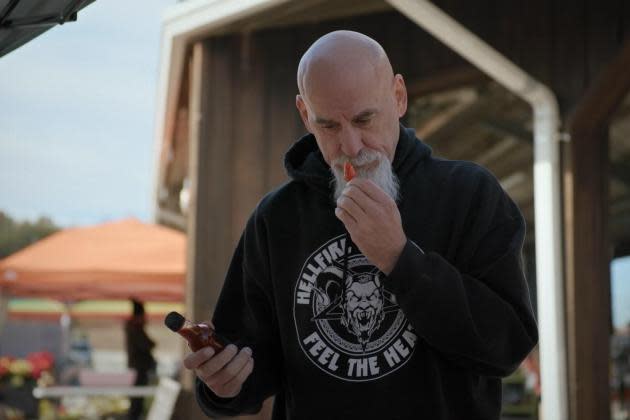Hulu Series ‘Superhot’ Shows Why Pepper People and Chili Heads Love Feeling the Burn, From Frozen Toilet Paper to Tasting the Hottest Peppers

Not everybody enjoys feeling the burn. But in the tight-knit world of chili heads who compete to see who can eat the most uber-spicy peppers, the endorphin rush that comes from capsaicin — the component in peppers that brings the heat — is a high worth pursuing. The contestants, the pepper growers trying to breed increasingly spicy pods, the hot sauce-makers tinkering with their recipes in their kitchens and the reviewers who chronicle this world on YouTube and social media are all featured in Hulu’s new show “Superhot: The Spicy World of Pepper People.”
The 10-episode “Superhot” goes deep inside the world of pepper personalities like Johnny Scoville, a popular reviewer and YouTube host; Aurea DeGuzman, a relative newcomer who grows peppers and makes her own hot sauce; Shahina Waseem, a British pepper-eating champion who’s never lost a competition and Troy Primeaux, grower of one of the world’s hottest peppers, the 7 Pot Primo.
More from Variety
Showrunner-director Brian Skope says the show, produced by High Noon Entertainment, Vox Media and David Chang’s Majordomo Media, came from the idea that “spice was taking over the cultural zeitgeist.” From the popular YouTube talkshow “Hot Ones” to the booming market for new hot sauces, “You were seeing heat everywhere,” he says.
Where the average foodie might enjoy a little Tabasco or enjoy trying habanero salsa and fiery vindaloo curry, these chili heads take their spice consumption to another level, competing around the country and abroad to chow down on dozens of the most scorching peppers at a time.
Skope says the producers set out to discover “what brings people into that world — it turned out to be such a rich community.” Searching out the dominant personalities in the space, one of the first mentioned was Scoville, who took his nom du chile from the Scoville unit, the measurement of heat in chilis.
Scoville, a drug former addict, says the world of heat has been a healthy substitute for him — as it is for many other chili heads.
“I know a million chili heads that are recovering from something,” says Scoville. “I’m very proud of my channel, but I’m more proud of my sobriety.”
“People will frequently say, so you quit one addiction for another? And my answer is, you betcha. This one is healthy. It’s legal. It brings people together. So yeah, it’s my addiction.”
The chili world started out as a fairly macho niche, but several women featured in the series have become prominent pepper people. DeGuzman is a nurse by day, but in her free time she cultivates dozens of pepper plants and works with her chili grower friend Bobby McFadden to create a new Filipino-themed sauce she calls Blazin Asian.

Waseem, known on social media as UKChilliQueen, is unusual in that she doesn’t like the flavor of peppers, but she discovered she’s very good at consuming a large number of blistering pods and winning competitions.
Of course, not everyone’s digestive system can ingest dozens of the searing fruits.
“There’s a lot of stages of trauma that you go through,” Scoville explains. “It starts just with your mouth, intense burning, but as it works its way through your system, it gets into your body and your stomach and then you start getting cramps in your hand. We call it ‘Naga claw.'”
Scoville describes some of the other afflictions that can befall the committed chili head. For instance, in the restroom, “When you pass liquid, it burns. Men call it firehose; women call it fire lily.”
“My dad died three years ago,” he recounts. “Every time I cried, my tears burn because there’s so much capsaicin in my nasal cavities.”
Though cooling the burn with liquids during competitions isn’t allowed (neither is puking), drinking milk or lemon juice or eating bread afterward will help combat some of the effects. But Scoville isn’t interested in being more comfortable. “I get bummed out when the pain goes away,” he says.
Some pepper people do, however, actually keep a stash of frozen toilet paper just in case. But Scoville says, “I wouldn’t do it if it killed me in the bathroom the next day. I’m a talented guy — I’d find a different gig.”
To show viewers what peppers do physically, Skope explains that the production used a pyrothechnics department and shot in a robot camera studio using macro and probe lenses to get into people’s bodies, “to see the irises, see the hair stick up,” he says.
Why subject yourself to that? For the thrill of competition, potential fame, and also for the rush, the series’ participants say.
“It’s an addiction,” Scoville admits. “The endorphin rush happens is because your body essentially feels like it’s dying. And it’s sending signals like, ‘Hey, we got a problem, help the dude out, send some endorphins!’ And that’s really at the heart of what drives the chili head, is that feeling.”
While DeGuzman, for example, is experimenting with various flavors to make her hot sauce stand out from the growing pack (collector Vic Clinco has more than 11,000 bottles at his home), some of the growers featured on the show are consumed by growing ever-hotter peppers, like the 7 Pot Primo which according to legend, can flavor up to seven entire pots of chili. But just how hot can the growers go? That’s the question “Superhot” aims to tackle.
“I do think it can get hotter,” says Skope. “I think these people are Frankensteins of agriculture.”
“There are some crazy people,” Scoville agrees, “who have a scientific, diabolical approach to it. There are always going to be hotter peppers.”
Best of Variety
Sign up for Variety’s Newsletter. For the latest news, follow us on Facebook, Twitter, and Instagram.


